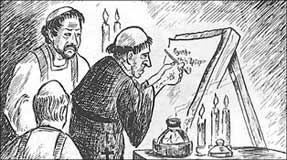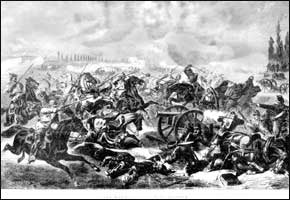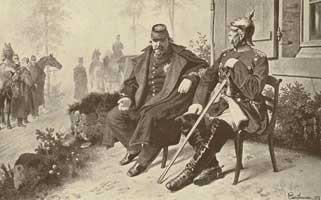SEPTEMBER 20 IS THE 151TH ANNIVERSARY OF THE LIBERATION OF ROMA (1870–2021). 1870 ALSO BEGAN THE COUNTDOWN TO THE END OF THE WORLD!! |
Saint John—the successor of the Messiah—was the quintessential numbers Saint. In the Apocalypse he gave us the number of the Beast (666), and the number 1260 appears frequently. In that case it clearly symbolizes years. Catholic monk Joachim of Fiore predicted that the Third Age of the "Holy Spirit" would begin in 1260.
Before he ascended to heaven, the Risen Messiah appeared to his disciples by the Sea of Galilee. The disciples were fishing all night and caught nothing, but at dawn the Messiah appeared on the shore and told them to cast the net on the right side. They obeyed, and a great catch of fish ensued. Very mysteriously, Saint John gives the exact number of fish:
Simon Peter went up and dragged the net to land, full of large fish, one hundred and fifty-three; and although there were so many, the net was not broken (Saint John 21:11, Douay-Rheims Version).
In one of his parables, the Messiah compared the end of the world scenario to a huge net full of fish:
Again, the kingdom of heaven is like unto a net, that was cast into the sea, and gathered of every kind: which, when it was full, they drew to shore, and sat down, and gathered the good into vessels, but cast the bad away. So shall it be at the end of the world: the angels shall come forth, and sever the wicked from among the just, and shall cast them into the furnace of fire: there shall be weeping and gnashing of teeth (St. Matthew 13: 47-50, Douay-Rheims Version).
The main difference between humans and demons in hell is the fact that demons cannot weep or cry, or show any remorse for their rebellion against the Almighty!
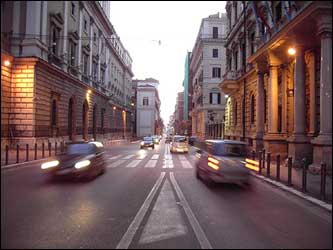 Via 20 Settembre in Roma. |
|
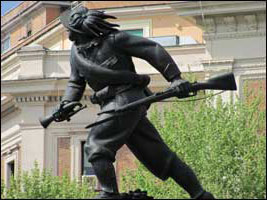 Statue of an Italian soldier breaking through Porta Pia to liberate the city. |
On October 28, 312 AD, Jesus Constantine won the Battle of the Milvian Bridge, and this opened the gates of Roma for his triumphal march into the city....As a Romanized Briton, the first "Christian Emperor" thanked Apollyon for giving him victory.
Roma was first occupied by Emperor Jesus Constantine in 313 AD
In 313, Emperor Jesus Constantine was recognized as the first "Christian" Emperor by the Roman Senate. This date can be considered as the official beginning of the Papal Roman Empire.
Beginning |
Years |
Ending |
Year
of actual fulfillment |
313 |
1260 |
1573 |
1588 |
606
|
1260
|
1866 |
1870 |
755 |
1260 |
2015 |
20?? |
Just before he died in 337, Emperor Jesus Constantine appointed Julius as the first Pope.
The Papal States were occupied by the Papal Pontiffs from 755 to September 20, 1870.
The Papal States were originally ruled from Constantinople by the viceroy of the Emperor called the exarch of Ravenna. The territories were conquered by the Lombards, and Pope Stephen II sought the help of King Pepin of the Franks to expel them.
Pope Stephen II convinced the illiterate and credulous King Pepin that "St. Peter" had sent him an airmail letter from heaven calling on him to defend Rome and expel the Lombards.
|
If we add 1260 to 755 it brings us to the fateful year of 2015.
The most infamous pious fraud in history was the airmail letter from "St. Peter" delivered to King Pepin commanding him
The temporal power of the Papal Pontiffs began in the year 755 when the Papal States were conceived in forgery and born in bloodshed and war.
There were 3 main reasons for their existence:
| 1 | The
Pontiffs did not have to answer to the civil power or any non-clerical
government. |
| 2 | Gold
and silver (real money) could be shipped to the Vatican without
the permission of the civil power.
|
| 3 | Secure
communications: Information obtained through the confessionals
could reach Roma securely. |
The abolition of the Papal States is condemned in the Syllabus of Errors of Pope Pius IX—the last king of the Papal States:
September 20th is the 150th anniversary (1870–2020) of the liberation of Roma from the Papal tyranny. A year later, on July 1, 1871, the Italian government moved from Florence to Roma, and the following day King Victor Emmanuel II entered the city.
The Prussian victory over Austria in 1866 prepared the way for the liberation of Roma!
Even though they spoke the same language, Prussia and Austria were bitter rivals. Reactionary Austria was the main pillar of the Papacy, while Prussia was supported by the British East India Company.
In 1858, Victoria, eldest daughter of Queen Victoria, married Prussian Crown Prince Frederick. They were the parents of the notorious "Dead Head" Kaiser Wilhelm II.
The Battle of Königgrätz (or Sadowa) was the decisive battle of the Austro-Prussian War in which the Kingdom of Prussia defeated the Austrian Empire. That decisive battle took place on July 3, 1866.
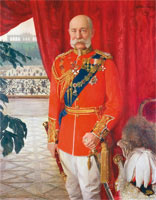 Emperor Franz Joseph (1830–1916). Misruled Austria from 1848 to 1916. |
|
 General Ludwig von Benedek (1804–1881). |
The Prussians sent several observers to the American Civil War, and they noticed the extensive use of railroads, the telegraph, the Henry and Spencer repeating rifles, and many other innovative war weapons.
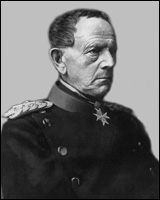 Field Marshall Helmuth von Moltke (1800–1891). |
|
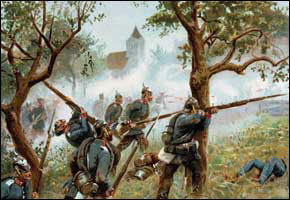 The Prussians using their breech-loading rifles at the Battle of Sadowa. |
Field Marshall von Molke's nephew by the same name commanded the Prussian army during the invasion of France in 1914. He lost his nerve and transferred an entire division to oppose the Russians. That led to a stalemate, and the bloody slaughter of WWI trench warfare.
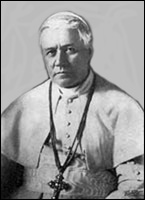 Pope Pius IX (1792–1878). Pope from 1846 to 1878. |
|
That council was extremely contentious, and the infallibility decree cost a fortune in gold and silver. Any cardinals who proved recalcitrant, and could not be bought, were sent to "St. Peter."
In August 1870, Emperor Napollyon III of France declared war on Prussia
After their decisive victory over Austria, the Prussians felt invincible. France was their only remaining rival in Europe, and Otto von Bismarck cleverly arranged that France would fire the first shot in his next war of conquest.
|
France lost thousands of soldiers in a vain attempt install Maximilian and Carlota as Emperor and Empress of Mexico. Napollyon needed a war to distract the people, and regain some of the lost prestige of his country.
Otto von Bismarck was able to maneuver France into firing the first shot of the Franco-Prussian War. Napollyon was confident of victory because he had an alliance with the newly created Austro-Hungarian Empire.
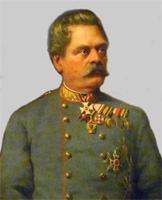 Franz Kohn von Kohnenfeld (1817–1896). Austro-Hungarian minister of war. |
|
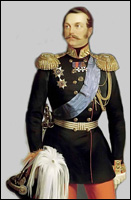 Czar Alexander II (1818–1881). Czar from 1855 to 1881. |
Napollyon was confident that its ally Austria-Hungary would join the war, and Austria was also thirsting for revenge because ofher defeat by Prussia in 1866:
Even before the French defeats, the Czar's declared intention of matching any Austrian declaration of war with one of his own had enabled Moltke to summon the three army corps standing along the Austrian frontier to join the armies in the Palatinate. The news of Wissembourg created in Vienna an uneasiness which only victory could have dispelled; and by 10th August the Austrian army had abandoned all the military preparations which it had half-heartedly begun. (Howard, The Franco-Prussian War, p. 120).
As a result of the French defeat, Czar Alexander abrogated the Treaty of Paris which blocked Russian access to the Black Sea.
|
Without the participation of the Austrians, France was doomed. The Prussians applied the lessons learned in the American Civil War to all phases of the brief conflict.
General Cadorna led the liberating Italian army into Roma!!
Italian general Raffaele Cadorna led the conquering host into the city of Roma. .
 General Raffaele Cadorna (1815–1897). |
|
Immediately afterward, a PLEBISCITE or VOTE was held to give the Romans a choice between the Papal or Italian governments.
At the time of the liberation, Roma had a population of about 240,000. Immediately afterward, the Italian government organized a popular PLEBISCITE so that the Romans could choose between the Papal or Italian government.
Italian Prime Minister Giovanni Lanza ordered general Cadorna to halt at the Leonine Wall surrounding the Vatican. They were not to be included in the plebiscite. Of course, the 1,500 inhabitants were furious that they were not allowed to vote.
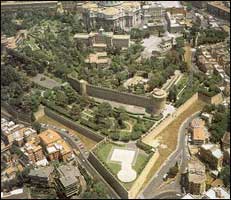 The Leonine Wall surrounding the Vatican. |
|
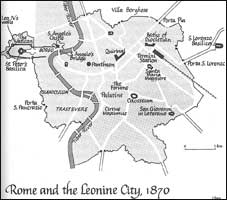 Map of the Leonine Wall. |
135,000 votes were cast in the Roman plebiscite, and the overwhelming majority voted to be part of the kingdom of Italy:
It was in this somewhat troubled atmosphere that the plebiscite duly took place on October 2. The most perfect order was maintained despite the prevailing excitement. Some fifteen hundred inhabitants of the Leonine City crossed the bridge of S. Angelo, set up their own polling-place, and cast a unanimous vote in favor of annexation to Italy. They then apprised the authorities of the result. On the evening of the third, all the ballot boxes were brought to the Campidoglio. Some embarrassment ensued when an old resident of the Leonine City, accompanied by a large number of fellow Trasteverians, presented the votes of his district. The Giunta appealed to Baron Blanc, who represented the government at these rites, and someone expressed the opinion that, for diplomatic reasons, it might be advisable to follow a special procedure in this instance. But the baron unhesitatingly replied: "Forward, Romans of the Trastevere," and their votes were registered with all the others. The tabulation of the results showed an overwhelming triumph for the national cause. Of the 135,291 votes cast, 133,681 were in favor of union, 1507 were against, and 103 were classified as invalid. (Halperin, Italy and the Vatican at War, pp. 108-109).
The 1,500 Leonine City inhabitants lived closest to the Papal government; they had an opportunity to observe it up close and personal . . . and they rejected it overwhelmingly!
Giuseppe Garibaldi shares a birthday with the New Jerusalem!!
Giuseppe Garibaldi was the driving force behind the unification of Italy. He yielded the physical sword, while Alessandro (the Great) Gavazzi yielded the spiritual sword.
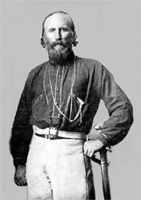 Giuseppe Garibaldi (July 4, 1807– June 2, 1882). |
|
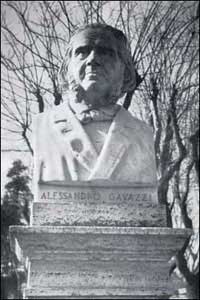 Alessandro (the Great) Gavazzi (1809–1889). |
Garibaldi was intensely disappointed that Pope Pius IX was allowed to stay in Roma after the liberation of the city. His fervent wish was permanent retirement for the Papacy.
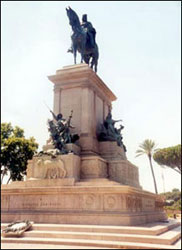 The Garibaldi monument on the Janiculum Hill. |
|
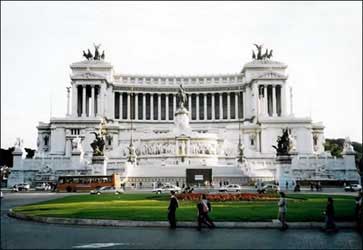 King Victor Emmanuel II monument in Roma. |
The saga of Roma did not end with the liberation of the city. Many, many attempts were made to regain the lost States. In 1929, "Sawdust Caesar" Benito Mussolini donated a small area in central Roma to the Papacy, and that captive area is now known as Vatican City State.
In 1979, an attempt was made by the Rockefeller-Pentagon-Mafia to divide up Italy one again and restore the Papal States!
Vital Links
References
Blakiston, Noel. The Roman Question: Extracts from the Dispatches of Odo Russell from Rome 1858–1870. Chapman & Hall, London, 1962.
Cadorna, Luigi, Il generale Raffaele Cadorna nel Resorgimento italiano. Fratelli Treves, Milano,1922.
Dicey, Edward.Victor Emmanuel II. G. P. Putnam's Sons, New York, 1882.
Duchesne, Monsignor L. The Beginnings of the Temporal Sovereignty of the Popes (754–1073). Kegan Paul, Trench, Thübner, & Co., London, 1907.
Forester, B.C. Victor Emmanuel II and the Union of Italy. Dodd, Mead & Co., New York, 1927.
Howard, Michael.The Franco-Prussian War. The Macmillan Company, New York, 1962.
Halperin, William S. Italy and the Vatican at War. University of Chicago Press, Chicago, Illinois. 1939.
Hinkley Edyth. Mazzini: The Story of a Great Italian. Kennikat Press, Port Washington, New York, 1924.
Kertzer, David I. Prisoner of the Vatican. The Pope's Secret Plot to Capture Rome from the New Italian State. Houghton Mifflin Co., Boston & New York, 2004.
Palmer, Alan. Twilight of the Habsburgs. The Life and Times of Emperor Francis Joseph. Grove Press, New York, 1994.
Smith, Denis. Mack. Victor Emmanuel, Cavour, and the Risorgimento. Oxford University Press, New York, 1971.
Smith, Denis Mack. Giuseppe Mazzini. Yale University Press, New Haven & London, 1994.
Smith, Denis. Mack. Count Camille de Cavour. Alfred A. Knopf, New York, 1985.
Stock, Leo Francis. Consular Relations Between the United States and the Papal States. (in 2 Volumes), American Catholic Historical Assoc., Washington City, 1945.
Wylie, Rev. J. A. The Awaking of Italy and the Crisis of Rome. U.S. Tract Society, New York, 1866.
Copyright © 2020 by Patrick Scrivener
